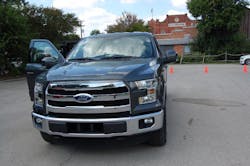Here’s a no brainer: when it comes to selecting the most important attribute of a new vehicle – be it a car, sport utility vehicle (SUV), or light truck – a new poll finds consumers put “fuel efficiency” at the top of the list, with sticker price a close second.
And we needed a survey to know this?
This particular poll – a “representative sample” of 1,006 U.S. adults comprised of 504 men and 502 women, 18 years of age and older – conducted by the Opinion Research Corporation on behalf of Johnson Controls found that fuel efficiency (57%), cost (55%) and safety (54%) are the top three characteristics consumers care most about when planning to buy any type of vehicle.
"Whether someone wants to drive a truck, SUV, or car, increased fuel efficiency remains the number one purchase criterion for American car buyers," noted Joe Walicki, president of Johnson Controls Power Solutions division, in a statement. “That preference is consistent with a similar survey conducted five years ago, despite falling gas prices, which are down more than 37% from the national average in 2011.”
He added that this latest survey also found consumers are “sensitive” to the price of fuel when considering a new vehicle, with 64% saying it directly impacts their purchase; up 14% from 2011.
"What we're seeing in the market place due to low and stable gas prices is a migration to larger vehicles, but the expectation now is that those vehicles come with increased fuel efficiency," Walicki stressed.
And, boy, are light trucks a hot seller of late.
Take the monthly light vehicle sales forecast issued jointly by J.D. Power and LMC Automotive for July: New-vehicle retail sales are expected to increase 2.1% from a year ago to 1.31 million units, with consumer spending on light vehicles poised to surpass $40 billion for just the fifth time in automotive history, even with modest sales growth, as new-vehicle retail transaction prices hit a record $30,601 last month.And light trucks accounted for 60.8% of new-vehicle retail sales in July, the two firms noted, adding that trucks accounted for more than 60% of monthly new-vehicle sales only four times on record.
[FYI: LMC’s full-year total light-vehicle sales forecast for 2016 now tops 17.4 million units, a slight decline of 0.1% or 15,000 units from 2015, meaning the automotive OEMs are still going full speed, unlike their compatriots in commercial truck manufacturing.]
"Automakers have made significant advances in fuel efficiency and have reduced emissions through implementation of several new technologies, such as turbo charging, engine downsizing and light weighting across their fleets," noted MaryAnn Wright, group vice president of technology and industry relations, at Johnson Controls.
[You can read more about those trends in this excellent roundup story by my colleague Aaron Marsh.]
Of course, efforts to boost fuel economy for light trucks – tapping everything from using new lightweight materials to smaller diesel engines and even new exterior shaping – is no doubt helping convince consumers they won’t spend more on fuel by switching over to a bigger vehicle.
Wright added, though, that more efforts are on deck – if not already being implemented – to deliver even more fuel savings for light vehicles.“The next big technology in the U.S. is start-stop, which increases fuel efficiency 5%,” she said – technology several commercial truck engine makers are already using.
Indeed, by 2020, Johnson Controls predicts 50% of all new vehicles in the U.S. will feature start-stop technology. GM plans to make it standard across its fleet by 2020 and Ford announced it will integrate start-stop across all vehicles equipped with its EcoBoost engines – which includes a goodly number of its light trucks, too.
"In the last year, there were more than twice the number of start-stop vehicles produced in the U.S. versus the total of all types of hybrid, plug-in and electric vehicles combined, and we see that trend continuing," Walicki said.
Petar Oklobdzjia, group vice president and general manager of original equipment for Johnson Controls, noted that start-stop technology enables a vehicle's engine to shut off during stops, such as red lights or traffic jams, while “accessories” such as lights, air conditioning and other functions continue to operate off of stored battery power.
When the driver lifts their foot off the brake, the engine “seamlessly restarts” and is ready to move the vehicle, he said.
We’ll see how all of this resonates with light truck buyers down the road. But one suspects that if it delivers better fuel economy with minimal sticker price increases, they will all be for it.


